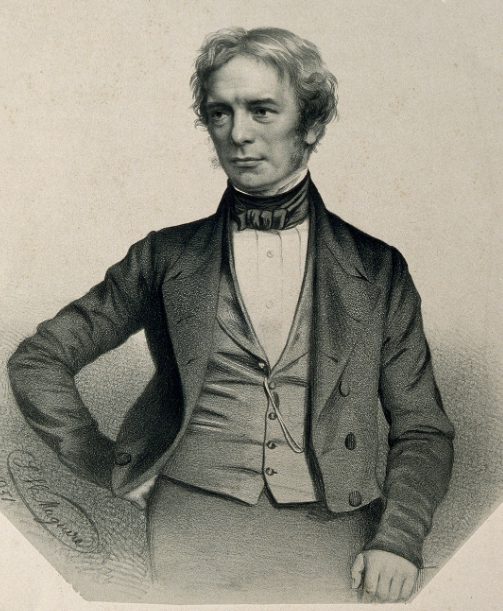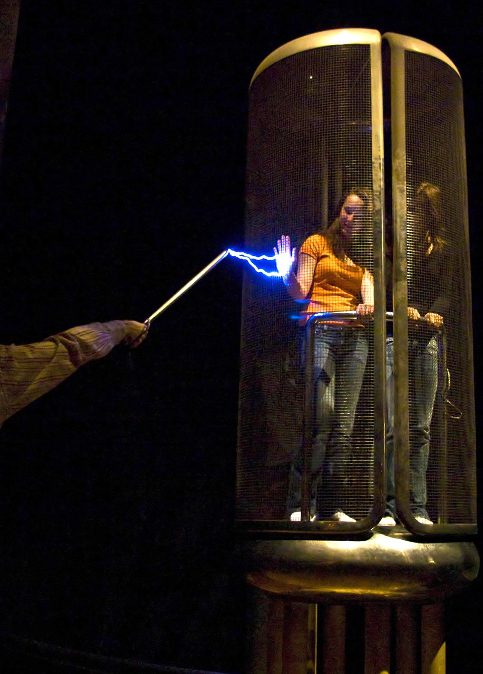Table of Contents:
A man placed in one row with those bearing the name of Newton, Einstein, Edison, Tesla and Bohr. An experimenter, a self-taught scientist, and an amazing mind. Let’s take a look at how we use Faraday’s ideas today.
Who was Michael Faraday?
A man whose work was fundamental to electricity. Michael Faraday was primarily a physicist and chemist. Although he experimented, he is not associated with inventions like, for example, Thomas Alva Edison, whose famous light bulb patent did not appear until 1879 twelve years after Faraday’s death.
He was not very good at mathematics, and his understanding of the myriad phenomena he studied was more intuitive. He was a tinkerer. Among the many things we can thank him for at least in some part today are electricity generated by electromagnetic induction, the carcinogenic but useful benzene, and, naturally, the Faraday cage.
In the first experimental demonstration of electromagnetic induction, Faraday wrapped two wires around opposite sides of an iron ring (torus). Based on his evaluation of the recently discovered properties of electromagnets, he expected that when a current began to flow in one of the wires, a kind of wave would flow through the ring and produce some electrical effect on the opposite side.
He connected one wire to the galvanometer and observed it while he connected the other wire to the battery. He did indeed observe a transient current, which he called a “wave of electricity,” when he connected the wire to the battery, and another when he disconnected it. It was caused by the change in magnetic flux that occurred when the battery was connected and disconnected.

He was not the brightest one at mathematics, and his understanding of the myriad phenomena he studied was more intuitive. He was a tinkerer. Among the many things we can thank him for at least in some part today are electricity generated by electromagnetic induction, the carcinogenic but useful benzene, and, naturally, the Faraday cage.
Electromagnetic induction
In the first experimental demonstration of electromagnetic induction, Faraday wrapped two wires around opposite sides of an iron ring (torus). Based on his evaluation of the recently discovered properties of electromagnets, he expected that when a current began to flow in one of the wires, a kind of wave would flow through the ring and produce some electrical effect on the opposite side. He connected one wire to the galvanometer and observed it while he connected the other wire to the battery. He did indeed observe a transient current, which he called a “wave of electricity,” when he connected the wire to the battery, and another when he disconnected it. It was caused by the change in magnetic flux that occurred when the battery was connected and disconnected.
Within two months, Faraday found several other manifestations of electromagnetic induction. For example, he observed transient currents when he quickly slid a bar magnet in and out of a coil of wires, and he also produced a direct current by rotating a copper disk near the bar magnet with a sliding electrical wire – today known as a Faraday disk.
Faraday cage – what is it?
A Faraday cage, sometimes referred to as a Faraday shield, is an enclosure that is used to shield objects from electromagnetic fields (both static and non-static). Static electricity is when charges are at rest, hence the name. In effect, they accumulate on the surface of a given insulator. Non-static or electric current is when electrons are moving in a conductor. Faraday cages are able to protect their contents, and even the people inside them, from the effects of both. They can be made of a continuous covering of conductive material or a fine mesh of conductive material.
Their design and size range from resembling chain mesh fencing to looking more like fine metal mesh. Regardless of their appearance, all Faraday cages accept electrostatic charges and even certain types of electromagnetic radiation and distribute them throughout the outside of the cage.

Passenger compartments in ground mass transit and airplanes are essentially Faraday cages to protect against lightning. And they protect more than just passengers – sensitive components may include wireless door locks, navigation/GPS systems, or lane departure warning systems. Faraday cages are used in analytical chemistry to reduce noise when making precise measurements. They are also used in digital forensics both before and after evidence collection, including to prevent remote erasure and alteration of evidence records. Elevators and other rooms with conductive metal frames and walls simulate the Faraday cage effect, leading to signal loss and “dead zones” for users of cell phones, radios and other electronic devices that require external electromagnetic signals. During training, firefighters and first responders are warned that their two-way radios will likely not work in elevators, and this should be taken into consideration. Small, physical Faraday cages are used by electronics engineers when testing equipment to simulate such an environment to make sure the device will perform well under such conditions. Finally – a cage comes in handy wherever you don’t want someone to suspect you or eavesdrop on you with the help of electronics.
Faraday cage at home – everyday applications

A Faraday cage can be used in a variety of everyday applications. For example in… theft.
A reinforcing shopping bag lined with aluminum foil acts as a Faraday cage and is increasingly being used by shoplifters to steal RFID-tagged items – the so-called booster bag. This handmade bag is used for theft usually from retail stores, libraries and other places where security sensors are used to deter theft. A booster bag can be an ordinary shopping bag, backpack, pocketed clothing or other inconspicuous container whose interior is lined with a special material, usually multiple layers of aluminum foil. Where’s the Faraday cage here?
The item is placed inside reinforcing bag – effectively a Faraday cage. This provides electromagnetic shielding, so that the electronic security tags inside the bag may not be detected by common “shop gates” – security panels in the detector antennas at the entrance/exit.
A Faraday cage at home will primarily protect our mighty electronics. They also offer absolute privacy offline – no GSM network, no GPS coverage, no WiFi. Nice tutoring material below in under 5 minutes.
How to prevent pickpocketing
Relax, you can go the other way too. Have you heard of skimming?
RFID skimming is a method of illegal acquiring of payment card information. Thanks to Faraday, today we know ways to prevent such theft. Shielding is possible by encasing the payment card in aluminum; however, aluminum foil tends to wear off quickly.
The shielding effect is not 100% effective, although it does reduce the maximum reading range. The distance unit values, however, are not entirely believable.

There are wallets, purses, cards and corresponding RFID blocking cases. They work by creating a screen around the card to stop the electromagnetic field. The RFID blocking card is the same shape and size as a regular credit card and is placed with the cards it is designed to protect. It’s such a jammer that activates automatically when someone tries to scan payment cards near it. Faraday cages for phones or keys are also becoming more common.
Just don’t try it at home, store or in other crowded public places – if it’s a tutorial, then it’s right-sided lesson on how to be prepared against thieves and scammers, not the other way around.
How useful was this post?
Click on a star to rate it!
Average rating 0 / 5. Vote count: 0
No votes so far! Be the first to rate this post.



















